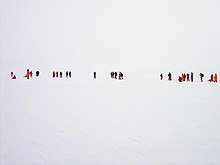Whiteout

A whiteout is a meteorological phenomenon that occurs mainly in polar regions and in high mountains .
Whiteout describes the brightness that can be observed with snow-covered ground and subdued sunlight (due to cloud cover, fog or snowfall). Due to the strong diffuse reflection of sunlight and the associated very high minimum luminance , there is a very strong reduction in contrast , the entire field of view seems to be evenly bright. The result is a disappearance of the horizon ; The ground and the sky merge seamlessly. Contours or shadows are also no longer recognizable and the observer has the feeling of being in a completely empty, infinitely extended gray room. In the case of appropriately predisposed people, this can lead to severe psychological stress, which is often expressed in the form of anxiety and feelings of fear. Physically, the whiteout is noticeable through disorientation and impairment of the sense of balance .
Whiteouts represent a serious hazard in mountain sports : For safety reasons, groups should stay close together and move slowly, if at all. In areas at risk of falling, you should if possible wait for the end of a whiteout and temporarily refrain from any movement, as obstacles or abysses can no longer be recognized and distances and the steepness of the ground can no longer be estimated.
A whiteout also represents a serious threat to aircraft that fly by sight , since in visual flight the attitude of the aircraft in relation to the natural horizon is assessed and the required distance to obstacles is also observed by sight. However, in aviation, situations in which the horizon disappears regardless of the lighting situation due to severe visibility restrictions due to fog or snowfall are also referred to as whiteouts.
Accidents due to a whiteout
- A whiteout in 1979 probably led to the accident on Air New Zealand flight 901 , among other things . This guided off-road flight was the most serious aviation accident on the Antarctic continent to date (257 fatalities).
- In April 1982 two helicopters of the British armed forces ( Royal Air Force ) flew into the area during the retaking of South Georgia in the Falklands War due to whiteouts in a snow storm.
- In March 2008, a Bo 105 helicopter from the research vessel Polarstern flew into an area of snow near the Neumayer II research station in Antarctica . Two people died and three were injured, some seriously. The reason for the accident was a whiteout due to the contrastless surface of the ice shelf .
- In January 2010, an MD 902 of the Lower Saxony police crashed after touching the ground in a snow-covered field near Elze (Wedemark) . At that time, the helicopter was being controlled by a flight instructor who wanted to demonstrate flight maneuvers as part of a training flight. Apparently the snow-covered surface combined with the cloudy sky caused the pilot to lose his orientation. Three people were slightly injured and the machine was totaled.
- Aircraft accident at the Berlin Olympic Stadium on March 21, 2013: A helicopter of the Federal Police collided with a helicopter that had recently landed on the Maifeld next to the Berlin Olympic Stadium , while the view was severely limited for a short time by the powder snow that was blown up by the rotor blades. The pilot of the helicopter that had already landed was killed.
Individual evidence
- ^ Falkland Islands - The recapture of South Georgia. (No longer available online.) Royal Air Force, archived from the original October 11, 2011 ; Retrieved August 20, 2011 . Info: The archive link was inserted automatically and has not yet been checked. Please check the original and archive link according to the instructions and then remove this notice.
- ^ Investigation report of the Federal Bureau of Aircraft Accident Investigation
- ↑ investigation report 3X002-10 , Federal Bureau of Aircraft Accident Investigation, accessed on April 21, 2018 (PDF, German, 482 KB).